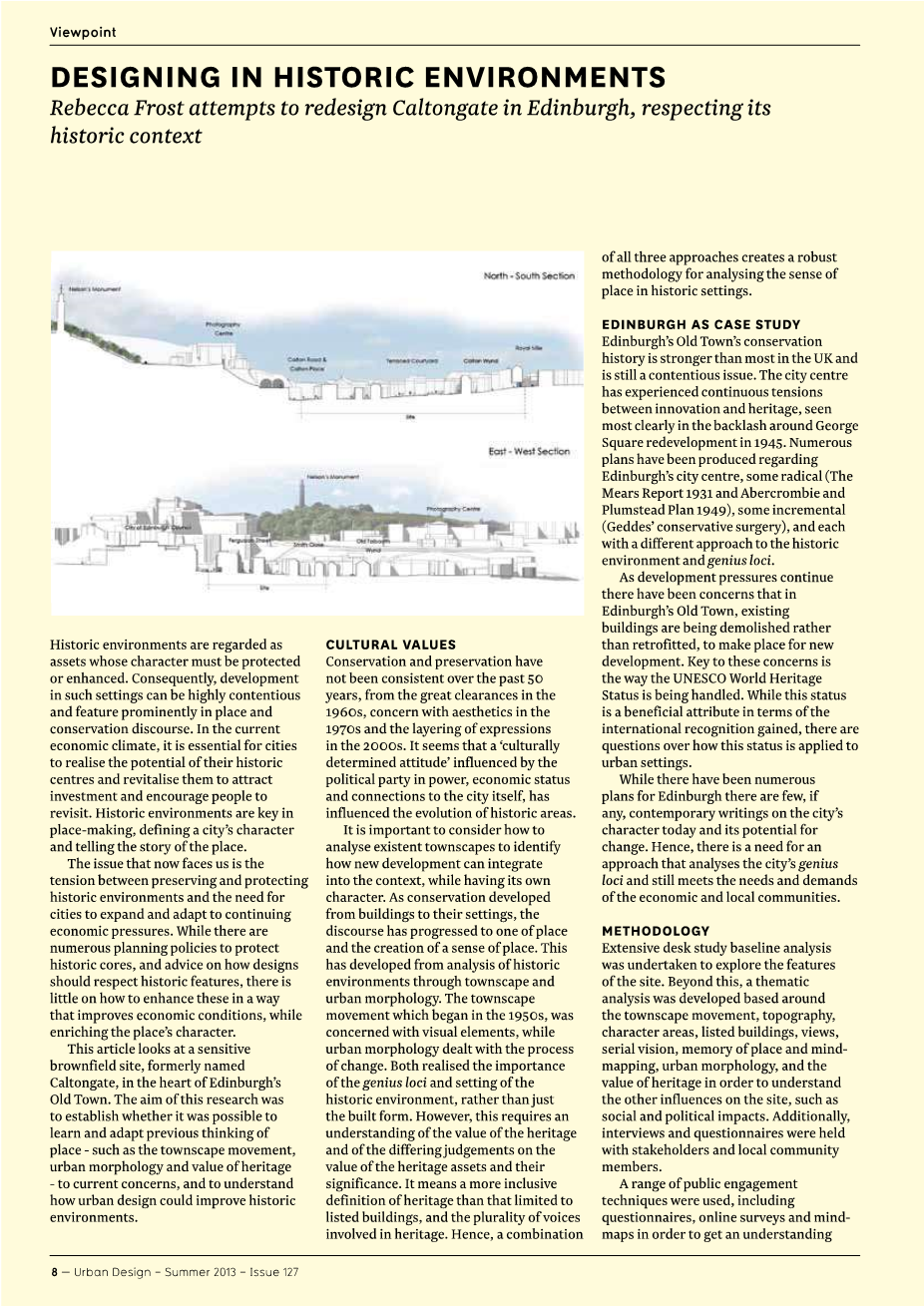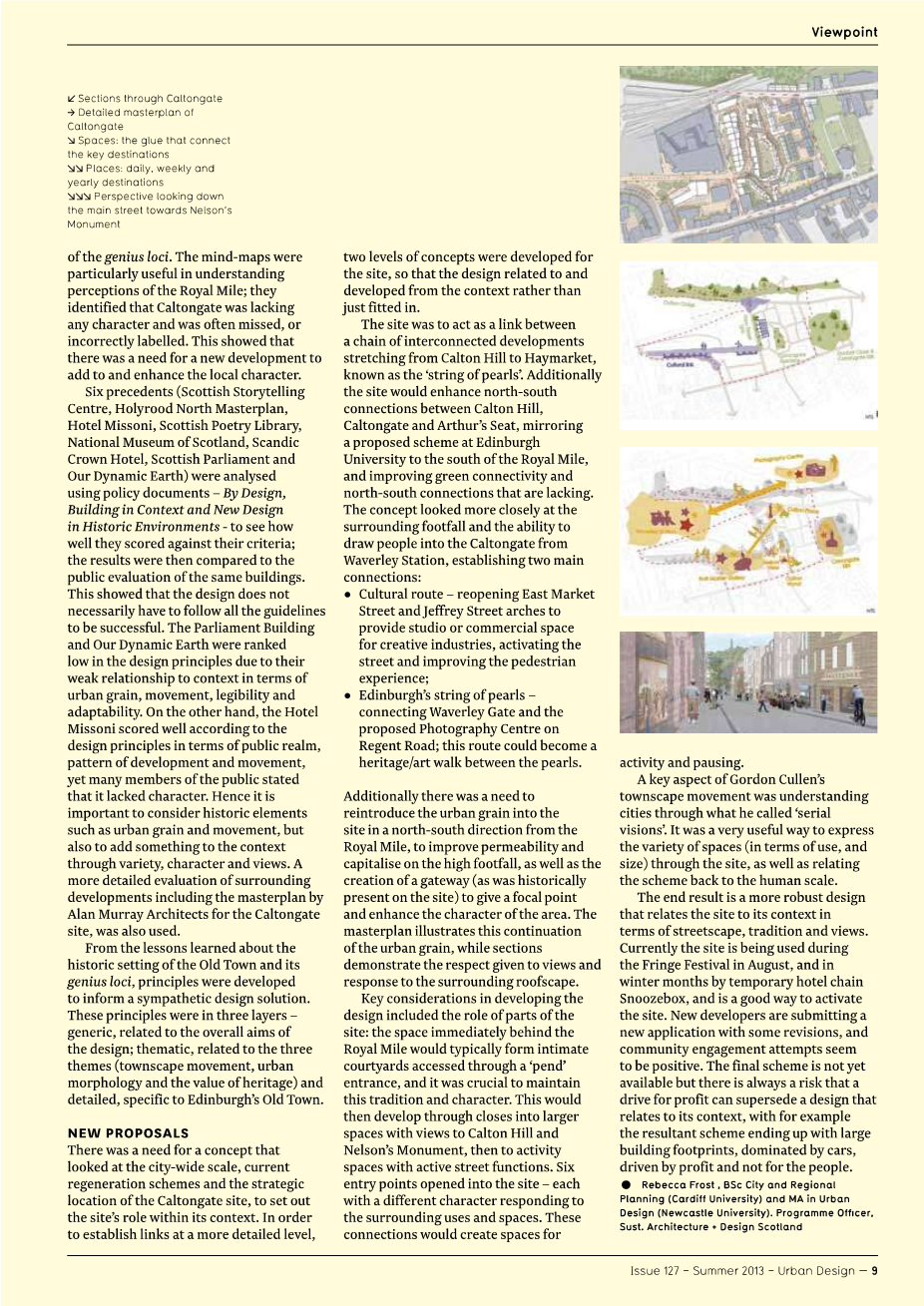

英语原文共 8 页,剩余内容已隐藏,支付完成后下载完整资料
Designing in Historic EnvironmentsRebecca Frost attempts to redesign Caltongate in Edinburgh, respecting its historic context Historic environments are regarded as assets whose character must be protected or enhanced. Consequently, development in such settings can be highly contentious and feature prominently in place and conservation discourse. In the current economic climate, it is essential for cities to realise the potential of their historic centres and revitalise them to attract investment and encourage people to revisit. Historic environments are key in place-making, defining a cityrsquo;s character and telling the story of the place. The issue that now faces us is the tension between preserving and protecting historic environments and the need for cities to expand and adapt to continuing economic pressures. While there are numerous planning policies to protect historic cores, and advice on how designs should respect historic features, there is little on how to enhance these in a way that improves economic conditions, while enriching the placersquo;s character. This article looks at a sensitive brownfield site, formerly named Caltongate, in the heart of Edinburghrsquo;s Old Town. The aim of this research was to establish whether it was possible to learn and adapt previous thinking of place - such as the townscape movement, urban morphology and value of heritage - to current concerns, and to understand how urban design could improve historic environments. Historic environments are regarded as assets whose character must be protected or enhanced. Consequently, development in such settings can be highly contentious and feature prominently in place and conservation discourse. In the current economic climate, it is essential for cities to realise the potential of their historic centres and revitalise them to attract investment and encourage people to revisit. Historic environments are key in place-making, defining a cityrsquo;s character and telling the story of the place. The issue that now faces us is the tension between preserving and protecting historic environments and the need for cities to expand and adapt to continuing economic pressures. While there are numerous planning policies to protect historic cores, and advice on how designs should respect historic features, there is little on how to enhance these in a way that improves economic conditions, while enriching the placersquo;s character. This article looks at a sensitive brownfield site, formerly named Caltongate, in the heart of Edinburghrsquo;s Old Town. The aim of this research was to establish whether it was possible to learn and adapt previous thinking of place - such as the townscape movement, urban morphology and value of heritage - to current concerns, and to understand how urban design could improve historic environments. Cultural values Conservation and preservation have not been consistent over the past 50 years, from the great clearances in the 1960s, concern with aesthetics in the 1970s and the layering of expressions in the 2000s. It seems that a lsquo;culturally determined attitudersquo; influenced by the political party in power, economic status and connections to the city itself, has influenced the evolution of historic areas. It is important to consider how to analyse existent townscapes to identify how new development can integrate into the context, while having its own character. As conservation developed from buildings to their settings, the discourse has progressed to one of place and the creation of a sense of place. This has developed from analysis of historic environments through townscape and urban morphology. The townscape movement which began in the 1950s, was concerned with visual elements, while urban morphology dealt with the process of change. Both realised the importance of the genius loci and setting of the historic environment, rather than just the built form. However, this requires an understanding of the value of the heritage and of the differing judgements on the value of the heritage assets and their significance. It means a more inclusive definition of heritage than that limited to listed buildings, and the plurality of voices involved in heritage. Hence, a combination of all three approaches creates a robust methodology for analysing the sense of place in historic settings. Edinburgh as case study Edinburghrsquo;s Old Townrsquo;s conservation history is stronger than most in the UK and is still a contentious issue. The city centre has experienced continuous tensions between innovation and heritage, seen most clearly in the backlash around George Square redevelopment in 1945. Numerous plans have been produced regarding Edinburghrsquo;s city centre, some radical (The Mears Report 1931 and Abercrombie and Plumstead Plan 1949), some incremental (Geddesrsquo; conservative surgery), and each with a different approach to the historic environment and genius loci. As development pressures continue there have been concerns that in Edinburghrsquo;s Old Town, existing buildings are being demolished rather than retrofitted, to make place for new development. Key to these concerns is the way the UNESCO World Heritage Status is being handled. While this status is a beneficial attribute in terms of the international recognition gained, there are questions over how this status is applied to urban settings. While there have been numerous plans for Edinburgh there are few, if any, contemporary writings on the cityrsquo;s character today and its potential for change. Hence, there is a need for an approach that analyses the cityrsquo;s genius loci and still meets the needs and demands of the economic and local communities. Methodolog Extensive desk study baseline analysis was undertaken to explore the features of the site. Beyond this, a thematic analysis was developed based around the townscape movement 剩余内容已隐藏,支付完成后下载完整资料 资料编号:[152989],资料为PDF文档或Word文档,PDF文档可免费转换为Word |
您可能感兴趣的文章
- 饮用水微生物群:一个全面的时空研究,以监测巴黎供水系统的水质外文翻译资料
- 步进电机控制和摩擦模型对复杂机械系统精确定位的影响外文翻译资料
- 具有温湿度控制的开式阴极PEM燃料电池性能的提升外文翻译资料
- 警报定时系统对驾驶员行为的影响:调查驾驶员信任的差异以及根据警报定时对警报的响应外文翻译资料
- 门禁系统的零知识认证解决方案外文翻译资料
- 车辆废气及室外环境中悬浮微粒中有机磷的含量—-个案研究外文翻译资料
- ZigBee协议对城市风力涡轮机的无线监控: 支持应用软件和传感器模块外文翻译资料
- ZigBee系统在医疗保健中提供位置信息和传感器数据传输的方案外文翻译资料
- 基于PLC的模糊控制器在污水处理系统中的应用外文翻译资料
- 光伏并联最大功率点跟踪系统独立应用程序外文翻译资料



